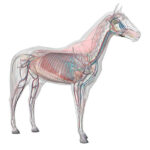Respiratory Health
Eliminating dust and spores in the stable has always been our No.1 priority
We began making Bedmax shavings in 2000 in response to demand from leading racing trainers in the UK for a natural bedding alternative to straw, with the lowest possible levels of airborne dust.
Over the past 25 years, equine veterinary research has confirmed the threat of respiratory disease caused by airborne dust in the stable, and our determination to eliminate dust has made our shavings first choice for owners across the full spectrum of the equestrian world.
Airborne dust and spores can cause a wide range of reactions in the respiratory system ranging from temporary mild irritation, causing limited inflammation of tissue and mucus production, through to severe allergic reactions and RAO (COPD) which can permanently damage the respiratory system and terminate a horse’s career and even their life.


Defining Airborne Dust
Horses in stables are subject to concentrations of airborne dust up to 50 times higher than outside, and poor bedding is a major source of this dust. Veterinary research has established that the largest size of particle that can become airborne and pass into a horse’s respiratory system is approximately 4 microns. Throughout production of Bedmax shavings we screen out and vacuum-extract virtually all particles smaller than 400 microns.
Survey Evidence
National equestrian surveys carried out over the past 20 years by the British Equestrian Trade Association (BETA) show that:
- Over 50% of owners now use purpose-made wood shavings
- Bedmax is the most popular brand of purpose made shavings in the UK
Our own regular Equine Health Surveys confirm that:
- Over 80% of horses in the UK spend at least 12 hours out of every 24 in their stables
- Respiratory problems are the most common cause of veterinary call-outs for equine ill health (as opposed to injury)
Scientific Evidence
“The short-term athletic ability and long-term welfare of horses are largely dependent on respiratory health and wellbeing.”
Global veterinary research in the 1980s and 1990s proved that even small amounts of airborne dust in bedding can seriously compromise a horse’s respiratory system. The effects can vary from mucus-producing irritation to chronic disease, but even a mild response can reduce the horse’s lung capacity and prevent it from performing at its best.
Research 1999
“Dust appears to enhance both the prevalence and severity of respiratory diseases, especially conditions such as chronic obstructive pulmonary disease (COPD / RAO). It may also aid the spread of other infections…
There is also evidence that inhaled airborne particles reduce the exercise tolerance of clinically normal horses…
The level of airborne particles present in stables is dependent on sources including the animals themselves, their dung and urine, bedding, feed, and incoming air…
Bedding, dung and urine are the most significant sources of airborne dust in stables…Bedding is more important than ventilation as a cause of dust…
Straw and paper both promote the growth of fungal spores more than wood-shavings.”
Reducing Dust in Horse Stables:
1999, Dr Colin Cargill, Principal Research Veterinarian South Australian Research and Development Institute
Research 2006
“Several equine respiratory disorders are directly caused by or exacerbated by the inhalation of airborne dust, with the widely recognized example of this being recurrent airways obstruction (RAO)…
The findings of Clarke (1987) that straw contained heavy counts of primary mould spores, whereas wood shavings contained negligible to moderate amounts (unless used in a deep litter system which released heavy spore counts) are in agreement with the findings of the present study…
…Changing bedding from straw to wood savings results in …up to 78% reduction in maximum RDC (levels of airborne dust and spores)…”
Respirable dust concentrations (RDC) in equine stables:
2006 Dr Scott Pirie, J M Clements, Veterinary Clinical Studies, Royal School of Veterinary Studies, Edinburgh
The Expert View on Respiratory Health
Dr Emmanuelle van Erck Westergren is one of Europe’s leading equine veterinary experts specialising in respiratory disease in horses.
In a major interview with Bedmax in 2021, Dr van Erck explained the types of respiratory disease she encounters, the causes, the lessons we can learn from Covid, and the crucial importance of eliminating dust from the stable.
Over the past 10 years as an international consultant vet, Dr van Erck has treated hundreds of horses other vets have not been able to cure. Around 80% of these horses turn out to be suffering from inflammation and/or disease of their respiratory system.
“Yes, respiratory disease is prevalent, and although my cases are almost all high performance horses it’s just as widespread in leisure horses…
Should I be worried about my horses’ respiratory health?
In a major interview with Bedmax in 2021, Dr van Erck explained the types of respiratory disease she encounters, the causes, the lessons we can learn from Covid, and the crucial importance of eliminating dust from the stable.
The causes, symptoms and effects of respiratory disease.
In part two of our series on ‘understanding equine respiratory disease’ we look at the main causes, symptoms and effects of equine respiratory disease.
Learning from Covid
The coronavirus pandemic has been a massive human health threat, but one of Europe’s leading veterinary specialists in equine respiratory disease tells us that Covid can teach us invaluable lessons about the importance of respiratory healthcare for our horses.
Equine Health Advice & Resources
Promoting preventative horse health care










